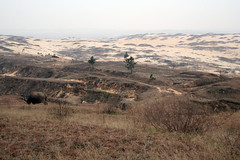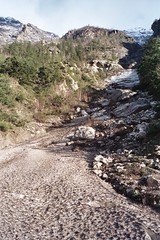When we think of how humans will deal with changing climate and the disasters that are likely to be its hallmark, the temptation is to assume that we'll confront the problem just like we've confronted Nature and the environment throughout human history - we'll invent ways to overcome the climatic effects through brute force or elegant design. That's what humans do, right?
One reason I started Climate Change, with its curious approach to the future, is that I've long given up on the idea that we humans are so smart that we can continue to outperform Nature. I've become persuaded that Nature now has the upper hand and we're going to have to adapt in ways more characteristic of the rest of the creatures, which is to not depend on single solutions quickly chosen.
In a great essay found on the TomDispatch blog, writer Chip Ward describes how efficiency - the maximization of output combined with the minimization of cost - is likely to lead to disaster in the search for adaptive paths to climate change.
Diesel-Driven Bee Slums and Impotent Turkeys: The Case for Resilience reminds us how efficiency - finding the "one best" solution to a problem - hates redundancy, and how natural adaptive systems rely on redundancy for the survival of species through crises. Redundancy is an essential element of resiliency.
Think of resiliency, on the other hand, as the ability of a system to recover from a disturbance. Recovery requires options to that one "best" way of doing things in case that way is blocked or disturbed. A resilient system is adaptable and diverse. It has some redundancy built in. A resilient perspective acknowledges that change is constant and prediction difficult in a world that is complex and dynamic. It understands that when you manipulate the individual pieces of a system, you change that system in unintended ways. Resilience thinking is a new lens for looking at the natural world we are embedded in and the manmade world we have imposed upon it.So as we observe and report on activities meant to adapt to changing climate, we'll also be noting to what extent these adaptations include elements of resiliency? Will the solution simply set up the population for failure at another point on the Nature/human interface, or will it serve to more closely integrate the population with the new natural order of things?
Restoring resilience to manmade systems will require an eye for options, an appreciation for redundancy, and a tolerance for chaos. Messy organizations may also be creative. But, hard as it may be, we will always find it easier to anticipate disturbance and build choices into our manmade systems than to understand how to conserve resilience in the natural systems that support us. To do that, we must grasp the deep underlying relationships between such "slow variables" as weather, soil composition, and plant succession that we often miss. We will have to learn to see how connectivity and feedback loops operate in nature and how futile it is, in the long run, to impose narrow notions of efficiency on natural systems that are profoundly dynamic and inherently unpredictable.
How resilient are we? Crisis is also an opportunity for change. As the bees die, we are getting an unmistakable warning. Without pollination, life as we know it is not possible. Think "tiny canaries in the coal mine." Then think "resilience."
Hopefully, we still have enough time and slack to exercise this new resilient thinking.


















